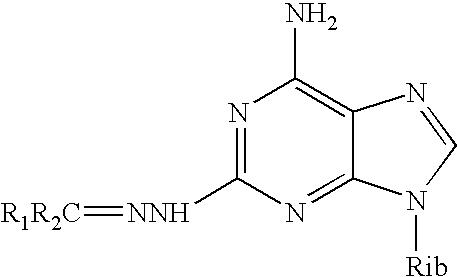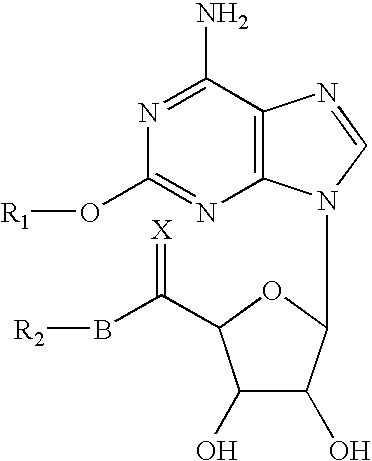2-polycyclic propynyl adenosine analogs having A2A agonist activity
a technology of polycyclic propynyl adenosine and agonist activity, which is applied in the direction of biocide, anti-inflammatory agents, drug compositions, etc., can solve the problems of side effects and inappropriate injury to host tissues, and achieve the effects of reducing morbidity and mortality, improving outcome, and promoting oxidative stability
Active Publication Date: 2006-02-23
UNIV OF VIRGINIA ALUMNI PATENTS FOUND +1
View PDF75 Cites 49 Cited by
- Summary
- Abstract
- Description
- Claims
- Application Information
AI Technical Summary
Benefits of technology
[0046] Additionally, the invention provides a therapeutic method for preventing or treating a pathological condition or symptom in a mammal, such as a human or equine, wherein the activity of A2A adenosine receptors is implicated and agonism of said receptors is desired, comprising administering to a mammal in need of such therapy, an effective amount of a compound of formula I, or a pharmaceutically acceptable salt thereof. It is believed that activation of A2A adenosine receptors inhibits inflammation by affecting neutrophils, mast cells, monocytes / macrophages, platelets T-cells and / or eosinophils. Inhibition of these inflammatory cells results in tissue protection following tissue insults.
[0050] The method of the invention will also be useful for treating patients with sepsis, severe sepsis, and potentially, the systemic inflammatory response syndrome, in addition to septic shock. The A2AAR agonists exert multiple anti-inflammatory effects early in the inflammatory cascade, and thus a short course of an A2AAR agonists could produce profound benefit in serious, life-threatening infectious and inflammatory disorders of humans, including inhalational anthrax, tularemia, escherichia and plague.
[0051] The anti-inflammatory effect of A2AAR agonists has been documented in vivo, in experimental models of meningitis, peritonitis and arthritis. The potentially fatal syndrome of bacterial sepsis is an increasingly common problem in acute care units. Sepsis and septic shock, now the eleventh leading cause of death in the United States, are increasing in frequency. Current estimates indicate that about 900,000 new cases of sepsis (approximately 60% Gram negative) occur in the United States annually with an estimated crude mortality rate of 35%. Furthermore, the mortality rate, as assessed in recent clinical trials, is approximately 25%, while approximately 10% of patients die from their underlying disease. Shock develops in approximately 200,000 cases annually with an attributable mortality rate of 46% (92,000 deaths). Sepsis accounts for an estimated $ 5-10 billion annually in health care expenditures. It is now widely appreciated that among hospitalized patients in non-coronary intensive care units, sepsis is the most common cause of death. Sepsis syndrome is a public health problem of major importance. A2AAR agonists are anticipated to have use as a new and unique adjunctive therapeutic approach to reduce morbidity and mortality. It is believed that this treatment will improve the outcome in systemic anthrax, tularemia, escherichia and plague.
[0052] The agonists of A2A adenosine receptors of the invention can inhibit neutrophil, macrophage and T cell activation and thereby reduce inflammation caused by bacterial and viral infections. The compounds, in conjunction with antibiotics or antiviral agents can prevent or reduce mortality caused by sepsis or hemolytic uremic syndrome or other inflammatory conditions. The effects of adenosine A2A agonists are enhanced by type IV phosphodiesterase inhibitors such as rolipram.
Problems solved by technology
The body's response becomes an agent of disease when it results in inappropriate injury to host tissues in the process of eliminating the targeted agent, or responding to a traumatic insult.
However, R-PIA and Cl-Ado analogs are actually more potent activators of A1 adenosine receptors than of A2A adenosine receptors and, thus, are likely to cause side effects due to activation of A1 receptors on cardiac muscle and other tissues causing effects such as “heart block.”
Method used
the structure of the environmentally friendly knitted fabric provided by the present invention; figure 2 Flow chart of the yarn wrapping machine for environmentally friendly knitted fabrics and storage devices; image 3 Is the parameter map of the yarn covering machine
View moreImage
Smart Image Click on the blue labels to locate them in the text.
Smart ImageViewing Examples
Examples
Experimental program
Comparison scheme
Effect test
example 1
5-[6-Amino-2-(2-hydroxy-bicyclo[2.2.1]hept-2-ylethynyl)-purin-9-yl]-3,4-dihydroxy-tetrahydro-furan-2-carboxylic acid cyclopropylamide
[0296]
example 2
5-[6-Amino-2-(2-hydroxy-bicyclo[2.2.1]hept-2-ylethynyl)-purin-9-yl]-3,4-dihydroxy-tetrahydro-furan-2-carboxylic acid cyclopropylamide
[0297]
example 3
5-[6-Amino-2-(2-hydroxy-adamantan-2-ylethynyl)-purin-9-yl]-3,4-dihydroxy-tetrahydro-furan-2-carboxylic acid cyclopropylamide
[0298]
the structure of the environmentally friendly knitted fabric provided by the present invention; figure 2 Flow chart of the yarn wrapping machine for environmentally friendly knitted fabrics and storage devices; image 3 Is the parameter map of the yarn covering machine
Login to View More PUM
| Property | Measurement | Unit |
|---|---|---|
| Flow rate | aaaaa | aaaaa |
| Therapeutic | aaaaa | aaaaa |
| Pharmaceutically acceptable | aaaaa | aaaaa |
Login to View More
Abstract
The invention provides compounds having the following general formula (I): wherein X, R1, R2, R7 and Z are as described herein.
Description
RELATED APPLICATIONS [0001] This application claims priority from a provisional application entitled: “2-POLYCYCLIC PROPYNYL ADENOSINE ANALOGS WITH MODIFED 5′-RIBOSE GROUPS HAVING A2A AGONIST ACTIVITY”, filed on Aug. 2, 2004, Ser. No. 60 / 598,184, the entire contents of which is included herein by reference.GOVERNMENT FUNDING [0002] The invention described herein was made with government support under Grant Number (RO1-HL37942), awarded by the National Science Foundation. The United States Government has certain rights in the invention.BACKGROUND OF THE INVENTION [0003] The inflammatory response serves the purpose of eliminating harmful agents from the body. There is a wide range of pathogenic insults that can initiate an inflammatory response including infection, allergens, autoimmune stimuli, immune response to transplanted tissue, noxious chemicals, and toxins, ischemia / reperfusion, hypoxia, mechanical and thermal trauma. Inflammation normally is a very localized action, which ser...
Claims
the structure of the environmentally friendly knitted fabric provided by the present invention; figure 2 Flow chart of the yarn wrapping machine for environmentally friendly knitted fabrics and storage devices; image 3 Is the parameter map of the yarn covering machine
Login to View More Application Information
Patent Timeline
 Login to View More
Login to View More IPC IPC(8): A61K31/7076C07H19/16
CPCC07H19/16A61K51/0491A61P29/00
Inventor RIEGER, JAYSON M.LINDEN, JOEL M.MACDONALD, TIMOTHY L.SULLIVAN, GAIL W.MURPHREE, LAUREN J.FIGLER, ROBERT ALANTHOMPSON, ROBERT DOUGLAS
Owner UNIV OF VIRGINIA ALUMNI PATENTS FOUND
Features
- R&D
- Intellectual Property
- Life Sciences
- Materials
- Tech Scout
Why Patsnap Eureka
- Unparalleled Data Quality
- Higher Quality Content
- 60% Fewer Hallucinations
Social media
Patsnap Eureka Blog
Learn More Browse by: Latest US Patents, China's latest patents, Technical Efficacy Thesaurus, Application Domain, Technology Topic, Popular Technical Reports.
© 2025 PatSnap. All rights reserved.Legal|Privacy policy|Modern Slavery Act Transparency Statement|Sitemap|About US| Contact US: help@patsnap.com



